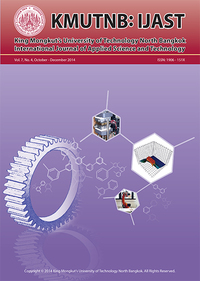Morphology and Crystallization of Polypropylene/Microfibrillated Cellulose Composites
Main Article Content
Abstract
Microfibrillated cellulose (MFC) was prepared by controlling the re-precipitation of cellulose prepared in the mixture form of NaOH/Urea solubilized microcrystalline cellulose (MCC) and starch. The cellulose re-precipitation was carried-out in an HCl bath, resulting in a MFC form having relatively lower crystallinity than MCC. The XRD pattern of MFC indicated the partially crystalline structure arising from the imperfect orientation of a cellulose chain obstructed by a starch molecule in the precipitation step. Interestingly, the MFC morphology exhibited a web-like structure with a diameter in the range of 10-20 nm. The water retention value of MFC was extraordinarily high due to its extremely small diameter having high surface area. Further, surface silanization of MFC with organosilane was carried out. Then, the modified MFC was melt-mixed with polypropylene (PP) matrix via a simple melt mixing technique. The morphology and crystallization of the PP/MFC composites were measured. The morphology of organosilane treated MFC exhibited agglomeration of 10 microns in diameter with layered structures arising from the packing of microfibrils. The FTIR spectra showed hydrophobic characteristics of treated MFC observed by the disappearance of original cellulose hydroxyl group and bound water. The crystallinity of treated MFC increased when compared to the untreated MFC, indicating that cellulose chains of unmodified MFC underwent re-orientation occurring in the modification step due to its high crystallinity characteristic. For the PP/MFC-composite containing MFC loading, faster crystallization and higher spherulite growth rate, in case of higher MFC loading, were observed. In addition, the spherulite size decreased with an increase in the crystallization temperature. However, the degree of crystallinity was fairly independent on the MFC-loading. Therefore it can be concluded that the addition of MFC might enable shorter cycle times, resulting in cheaper processing cost in a view point of polymer processing.


